Occupational environment monitoring at a light bulb manufacturing factory
99,000 ₫
Note: The above price is calculated per sample. Prices may vary depending on the area of the environment to be monitored and market fluctuations. For more accurate pricing, please refer to the price list or contact our consulting staff directly.
Monitoring the environment of a light bulb manufacturing factory involves a session of collecting, analyzing, and evaluating factors in the workplace that may be harmful to workers’ health.
Table of Contents
Toggle1. Overview of the Light Bulb Manufacturing Factory
a. What is a light bulb manufacturing factory?
Factory producing light bulbs is a facility that manufactures various types of light bulbs, LED lights, fluorescent lamps, and other lighting products. These bulbs are used in a wide range of applications, from household lighting to industrial, medical, and educational use. Light bulb manufacturing factories typically operate on a large scale and use automated production processes to produce consistent batches of lighting products.

b. Production stages in the light bulb manufacturing factory
The production stages in a light bulb manufacturing factory generally include:
- Cleaning and sterilization: This process ensures hygiene and safety during production. Glass bulbs and internal components are placed in equipment to remove dust, grease, and bacteria.
- Glass fabrication: This involves creating glass bulbs using materials such as limestone, silicate limestone, and various binders. The glass is then formed into bulbs of different sizes and shapes.
- Component assembly: During this stage, internal components are assembled, including the bulb base, tungsten filament, reflector glass, glass bulb, and gases. Assembly is usually done manually.
- Vacuum pumping and gas injection: Bulbs are placed in vacuum pumps and gas injection machines to create internal pressure. This process establishes an environment where the filament can burn without oxidizing or burning out.
- Drying and quality inspection: Finally, bulbs are dried and undergo quality inspection to ensure proper operation and compliance with safety and quality standards.

c. Machinery used in the light bulb manufacturing factory
Many types of machinery are used in a light bulb manufacturing factory to carry out different production stages. Some common machines include:
- Mechanical processing machines: Used to process metal parts such as bulb bases, lamp heads, pins, and other components.
- Copper pressing machines: Used to press copper into the shape of bulbs.
- Glass pressing machines: Used to shape glass into bulbs.
- Glass cutting machines: Used to cut glass into various shapes for assembly into bulbs.
- Oxidation water machines: Used to clean metal parts of bulbs before final assembly.
- Washing machines: Used to wash bulb components after processing.
- Quality inspection machines: Used to check the quality of bulbs before packaging and shipment.

d. Occupational diseases that may occur for light bulb factory workers
The risks and occupational diseases for workers in a light bulb manufacturing factory include:
- Light exposure: Working in light bulb production requires prolonged exposure to intense light, which may cause eye strain, dry eyes, and headaches.
- Electrical hazards: Factory work involves using electrical equipment such as welding machines and cutting machines. Risks include electric shock and explosions if safety procedures are not followed.
- Chemical exposure: Production involves chemicals like mercury, phosphorus, and lead. These toxic substances can cause respiratory issues, pneumonia, brain damage, and cancer.
- Exposure to dust and smoke: Production may generate harmful dust and fumes, leading to respiratory problems like asthma and pneumonia.
- Noise issues: Machinery in the factory can produce high noise levels, causing hearing problems.
All of these risks can lead to occupational diseases such as headaches, fatigue, and overall health deterioration.

e. Popular types of light bulbs on the market
There are many popular types of light bulbs on the market, including:
- Fluorescent bulbs: These bulbs generate light from fluorescent materials inside glass tubes. They are energy-efficient and used in desk lamps, ceiling lights, and other fixtures.
- LED bulbs: The newest type of bulb, durable and more energy-efficient than others. Used in decorative lighting, indoor and outdoor lighting.
- Incandescent bulbs: Classic bulbs that produce light by heating a filament. They consume more energy compared to newer types like LED.
- Halogen bulbs: Similar to incandescent bulbs but enclosed in halogen gas to extend lifespan and improve efficiency.
- Ultraviolet bulbs: Used for sterilization and disinfection in hospitals, laboratories, and other medical applications.

2. Overview of occupational environment monitoring services
a. What is occupational environment monitoring in a light bulb factory?
Occupational environment monitoring (or workplace environmental measurement) in a light bulb factory involves collecting, evaluating, and analyzing environmental indicators to implement timely measures, minimize harm to worker health, and prevent occupational diseases. Workplace monitoring is a mandatory requirement for light bulb manufacturing factories.
Occupational environment monitoring is crucial for safeguarding and enhancing worker health because employees are the primary resource and directly generate profit for the business. Workers regularly exposed to occupational hazards beyond permissible limits are at risk of health issues and occupational diseases.
REGISTER FOR OCCUPATIONAL ENVIRONMENT MONITORING SERVICE
b. Nam Viet’s occupational environment monitoring program
Nam Viet’s program is developed by engineers specializing in labor safety and environmental protection. It uses modern measurement methods to monitor air quality, water, microclimate, physical factors, and dust levels. This program is vital for ensuring a safe working environment and protecting worker health.
Additionally, Nam Viet’s program plays a key role in researching and developing new solutions to improve workplace environmental quality. With a dedicated and professional monitoring team, Nam Viet’s exclusive program is a breakthrough in labor safety management and environmental protection in Vietnam.

c. Standardization in occupational environment measurement procedures
Standardization in Nam Viet’s procedures ensures accurate and reliable results. The program follows recognized standards and procedures from the Ho Chi Minh City Department of Health, guaranteeing that collected data can be trusted for workplace evaluation and decision-making.
These standardized procedures are executed by highly skilled monitoring specialists, providing managers and experts with reliable results for protecting worker health and the environment.
By applying standardized procedures, Nam Viet demonstrates its commitment to safe workplaces and contributes to improving labor safety and environmental management in Vietnam.
d. Reporting results of light bulb factory monitoring
Monitoring results are prepared according to Form 04, Appendix III, issued with Decree 44/2016/ND-CP and made in two copies: one sent to the workplace that signed the monitoring contract, and one kept by the monitoring organization.
The storage period for monitoring results is indefinite according to legal regulations.

e. Frequency of occupational environment monitoring as required by law
According to Clause 2, Article 18, Labor Safety and Hygiene Law 84/2015/QH13, employers must monitor the workplace environment to evaluate harmful factors at least once a year.
f. Deadline for submitting occupational environment monitoring results
The submission deadline is before December 31 each year. Enterprises at production facilities must submit monitoring reports to the local Department of Health where the facility is headquartered and where employees are working.
If there are changes in technology, production processes, or upgrades introducing new hazards, enterprises must update occupational hygiene records regarding harmful factors requiring monitoring.
g. Penalties for violations of occupational environment monitoring regulations for employers
According to Article 27 of Decree 12/2022/ND-CP dated January 17, 2022, regulating administrative penalties in labor, social insurance, and Vietnamese employees working abroad under contracts:
- Clause 2: Fines from 2,000,000 – 5,000,000 VND for employers who fail to publicly announce monitoring results at the workplace immediately after receiving the results.
- Clause 3: Fines from 20,000,000 – 40,000,000 VND for employers who fail to conduct occupational environment monitoring as legally required.
- Clause 4: Fines from 40,000,000 – 60,000,000 VND for employers who collude with monitoring organizations to falsify monitoring activities, without criminal liability.
3. Harmful environmental factors for workers in a light bulb manufacturing factory
Harmful environmental factors for workers in a light bulb manufacturing factory may include:
- Dust and toxic fumes: The light bulb production process may generate metal dust and toxic fumes such as mercury, lead, argon, beryllium, and phosphorus, which are hazardous to workers’ health.
- High temperature: Machines in a light bulb factory usually operate at very high temperatures, causing discomfort for workers and potentially leading to heat-related illnesses such as heat exhaustion or excessive sweating.
- Noise: Large machinery in the factory often produces high noise levels, causing discomfort and potentially leading to ear-related illnesses, such as hearing loss.
- Glare: The production process may create glare, causing eye strain and discomfort. Additionally, light bulb components, such as glass or filters, may also produce glare and damage the eyes.
- Chemicals: Light bulb factories use chemicals for production, such as hydrofluoric acid, borax, ammonia, and other solvents. Improper use or lack of safety measures may harm workers’ health.
- Physical hazards: Handling and storing light bulbs may result in heavy objects falling or hard materials causing injuries to workers.
REGISTER FOR WORKPLACE ENVIRONMENT MONITORING SERVICE
4. Measures to improve working conditions in a light bulb manufacturing factory
Measures to improve working conditions in a light bulb manufacturing factory may include:
- Use personal protective equipment: Employees in the light bulb factory should be provided with protective equipment such as safety glasses, masks, gloves, and chemical-resistant gowns to protect their health.
- Improve production processes: Light bulb production should be designed to minimize harmful emissions and waste. Air and wastewater treatment equipment should be installed and operated effectively.
- Ensure proper ventilation and lighting: Work areas should have adequate ventilation and lighting to reduce exposure to harmful substances.
- Employee training: Employees should be trained in occupational safety and health to safely detect and handle hazardous situations.
- Inspect and maintain equipment: Factory equipment should be regularly inspected and maintained to ensure efficient operation and reduce the risk of incidents.
- Monitor air quality and wastewater: Factories should monitor air and wastewater quality to comply with environmental regulations and effectively address environmental issues.
- Periodically conduct workplace environment monitoring in factories, collect and analyze harmful factors for workers, and adjust to reduce risks to prevent occupational diseases.
5. Benefits of periodic workplace monitoring in light bulb factories
An Toan Nam Viet provides excellent benefits for businesses using occupational environment monitoring services according to Decree 44/2016/ND-CP on managing and controlling harmful factors in the workplace affecting workers.
- Businesses can proactively control harmful factors in workshops or factories.
- Receive advice and recommendations to minimize harmful factors and improve workplace quality.
- Indirectly protect human resources, a key factor in business development.
- Reduce occupational disease effects on human health, thereby reducing future treatment costs.
- Improved worker health leads to better product quality and sustained output.
- Comply with occupational safety laws, avoiding legal risks.
- Enhance credibility and professionalism in all aspects, boosting the company’s brand.
An Toan Nam Viet’s environmental monitoring service is a solution to minimize occupational disease risks, contributing to a clean and high-quality working environment.

6. Nationwide occupational environment monitoring center
An Toan Nam Viet Workplace Environment Monitoring Center is a professional unit in supervising and measuring occupational environment quality across all provinces in Vietnam. With a team of experienced monitoring specialists, the center uses modern measuring devices ensuring accuracy and reliability.
Besides providing monitoring services, the center assists clients in planning, handling, and following up on workplace environmental issues. With the motto “customer first,” the center prioritizes customer satisfaction and commits to offering the best solutions for businesses.
REGISTER FOR WORKPLACE ENVIRONMENT MONITORING SERVICE
With investments in technology, equipment, and human resources, An Toan Nam Viet’s monitoring center has become a reputable unit in workplace environment monitoring in Ho Chi Minh City with the following goals:
- We always value our brand reputation and the quality of our services.
- We provide clients with the best and most suitable solutions possible.
- Together with experienced Masters and Engineers, we aim to protect the environment and benefit businesses.
- Clients choosing An Toan Nam Viet Environmental Monitoring will receive professional service from experts and the best cost benefits.
The workplace monitoring process at An Toan Nam Viet includes the following basic steps:
- Before conducting monitoring, ensure all machinery and equipment are calibrated according to legal regulations.
- Follow the committed workplace monitoring procedures as agreed with the Department of Health.
- Report workplace monitoring results honestly to the employer.
- If monitoring results indicate unsafe conditions for workers, An Toan Nam Viet will support corrective measures, and the factory will implement:
- Implement measures to improve working conditions to minimize harmful factors and prevent occupational diseases.
- Organize health check-ups to detect occupational and related diseases early for employees in unsafe workplaces.
- Provide compensation in kind for workers as regulated by labor law.

7. Workplace environment monitoring price list
To help businesses perform professional and effective workplace monitoring, An Toan Nam Viet provides clients with a workplace environment monitoring service price list with high quality and reasonable cost.
- Our price list details the costs of all monitoring services we provide, including expenses for transportation, measurement, analysis, and reporting. Clients can trust the accuracy and reliability of our monitoring reports.
- We commit to offering competitive and reasonable prices while being ready to provide prompt and professional consultation on monitoring services.
- With An Toan Nam Viet’s price list, clients can easily choose service packages that meet their needs. We guarantee maximum satisfaction with professional service quality.
No comments yet

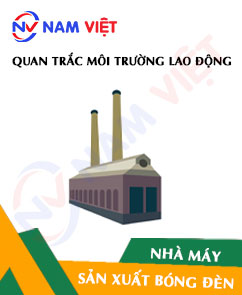
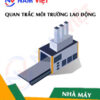
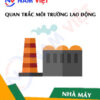
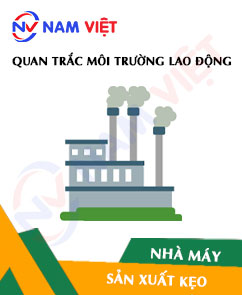




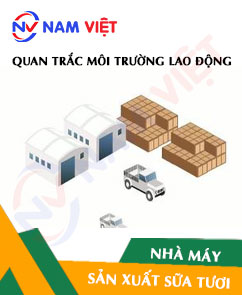


Review Occupational environment monitoring at a light bulb manufacturing factory
There are no reviews yet.